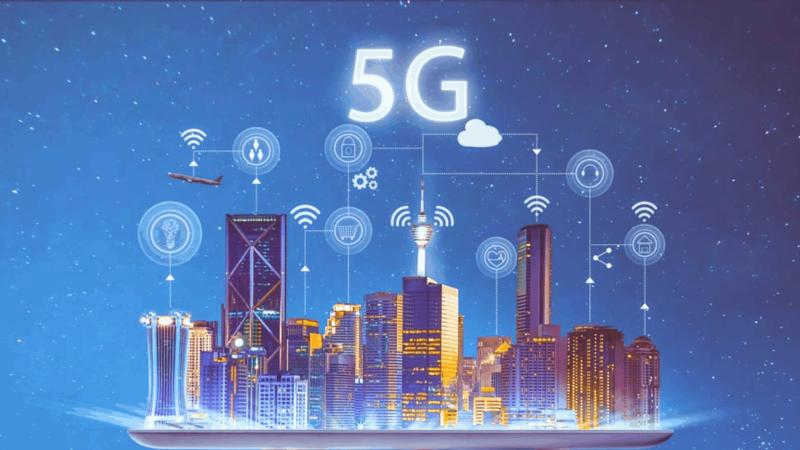5G In US : 5G Rollout in The United States

5G in US: 5G is the fifth generation of cellular networks. 5G is 100 times more faster than 4G, creating unprecedented opportunities for businesses and individuals. Ultra-low latency, Faster connectivity speeds, and greater bandwidth are powering societies, transforming industries, and dramatically improving everyday experiences. Services we once thought were futuristic, such as e-health, transportation systems, connected vehicles, and advanced faster mobile cloud gaming, have arrived. By using 5G technology, we can help create a safer, smarter, and more sustainable future. 5G is the fifth-gen wireless technology.
5G technology can provide higher speed, lower latency, and greater capacity than 4G LTE networks. It is one of the fastest and most robust technologies the world has ever seen.
That means faster downloads, far less lag, and a significant impact on how we live, work and play. 5G speeds and other connectivity benefits should make businesses more efficient and allow consumers to access more information faster than ever. Connected cars, smart stadiums, and advanced games depend on 5th Gen networks.
Table of Contents
5th GenerationTechnology: A brief history
To understand 5G, it helps to understand what preceded it. At its core, the first generation of cellular technology, 1G, was about voice – the ability to make calls in the Car or on the go has caught on. With the advent of 2G, a short messaging layer was introduced, elements of which can still be seen in the text messaging feature today. The move to 3G delivered the core network speeds needed to boot smartphones. And 4G, with its high data transfer rates, gave us a video with minimal buffering and spawned many of the devices connected and services we rely on and enjoy today. People are starting to get acquainted with 5G and its transformative capabilities. 5G has the great potential to reach speeds of 20 Gbps based on the 3GPP industry specifications.
Why is 5G Technology is important?
The race for 5G has been in the news for several years, especially in the technology and mobile sectors. That’s no surprise, 5G is expected to add an estimated $565 billion to the global economy by 2034, according to GSMA research. However, the slow materialization of 5G has prompted derogatory rhetoric about the technology being sensationalized and overhyped by mainstream media.
The reality is that access to 5G won’t drastically change the daily lives of maximum Americans. The 5G networks will be limited to large metropolitan areas due to the density of infrastructure required by 5G networks. Instead, the importance of 5G lies in its ability to usher in a new era of faster connectivity and lower latency that will impact many industries, transform the way business is conducted, and ultimately make the Internet of Things (IoT) ) a reality.
A fully functioning 5-G network is estimate to be at least ten times faster than an LTE network, and many experts have even estimated that figure to be 100 times faster. This level of connectivity is needed to make self-driving cars and robotic factories a reality.
More instant use of 5G is expected in network slicing, a practice that allows multiple networks to operate on a resolute platform. It represents a radical departure from current approaches and would allow automotive, government, logistics, media, and healthcare industries to benefit from tailored computing.
To put things into perspective, consider how quickly Uber connects you with drivers, saves the driving route, and then processes your payment, all in just a few clicks. Before LTE networks, an app like Uber would have been nearly impossible.
4G technology has opened up an ocean of possibilities and introduced new types of connectivity that seem commonplace today. Just as digitization has transformed our current market, 5-G will catalyze new business practices that are currently difficult to understand fully.
The Reality Of 5G In the United States
It is no secret that 5G technology adoption in the United States has been slower than expected. China and South Korea have achieved 5G milestones ahead of the United States. According to a Pentagon’s Defense Innovation Board report, “China is on track to replicate in 5G what happened to the United States in 4G.”
Why 5G distribution has been slower than expected in the United States
5G depends entirely on the electromagnetic spectrum, an extremely scarce resource and the essential basis for transmitting all wireless communication signals. But not all frequencies are created equal, which is one of the main reasons the US has found itself in a spectrum crisis amid the 5G push.
5G can only operate on specific frequencies in the US radio frequency spectrum due to regulatory restrictions. The FCC monitors and allocates the spectrum for non-governmental use by private and public organizations. For many years, most of the finest frequency bands for 5G deployments, known as the “midrange” spectrum — in the United States, have been allocates for federal use.
In 2019, the US sued mmWave over its 5G rollouts – a costly mistake that FCC Chairman Jessica Rosenworcel acknowledged. “If we relied solely on the millimeter wave spectrum, with 5G, we would be widening the digital divide,” Rosenworcel said in 2020. Although mmWave has a large capacity, the signals do not travel long distances. They do not easily penetrate obstacles, thus requiring expensive investments in dense ground infrastructure to achieve full functionality. In contrast, other countries have chosen to conduct their 5G deployments with the mid-band spectrum, known as the sweet spot for 5-G due to its capacity and propagation to send signals over relatively long distances.
What makes 5G different?
5G enables the transformation of society. It works on the same radio frequencies currently used for your smartphone, Wi-Fi networks, and satellite communications, but it allows the technology to go much further.
Aside from being able to download a Full High Definition movie to your mobile in seconds (even from a crowded stadium), 5G is truly about connecting things everywhere reliably and without lag. So, people can measure things in real-time, understand and manage.
This has massive potential, and we will take it to the next level.
Are you curious to know more about technology and what it means to you? Follow us on an in-depth journey and explain the differences between 5G and 4G.
Evolution of 5G
- Many changes took place since the first generation of mobile technology.
- The 1G era was characterizes by briefcase-sized phones and short conversations between a relatively small number of professionals.
- Before 2G, the demand for cellular services was growing and never slowing down.
- Pocket cellular phones, SMS, and mobile Internet access were hallmarks of the 3G world.
- Thanks to 4G, we have smartphones, app stores, and YouTube.
- Today, 5-G is completely transforming our professional and personal lives, enabling new use cases such as connected cars, augmented reality, enhanced video, and gaming.
What is 5G capable of?
It will not only improve your network connection dramatically. It opens up new possibilities and enables us to deliver breakthrough solutions that embrace society.
Imagine billions of connected devices sharing and collecting real-time information to reduce traffic accidents. These life-saving apps can take off with guaranteed lag-free connections or production lines that are so predictive they can prevent disruptions long before they happen. You don’t have to introduce yourself. We recognize it.
Advancing societies
- 5G opens up cutting-edge opportunities to improve safety and sustainability.
- Smarter power grids for significantly reduced CO2 emissions
- More and more connected vehicles are exchanging data to avoid road collisions
- Faster dispatch of emergency services in the event of an accident
- Networked sensors capable of detecting and warning of natural disasters at an early stage
- Drones are becoming a key tool to speed up and help respond to emergencies
- Remote expertise with specialists seamlessly consulting/diagnosing patients elsewhere
5G is changing industries
- 5G is the basis for a flexible, efficient, and responsible business.
- Production lines that respond autonomously to supply and demand
- Digital replicas that can give early warning of actual machine errors
- Logistics networks that route goods autonomously based on real conditions
- Full traceability down to the individual item in warehouses and ports
- Remote access to powerful robots and vehicles for increased safety in risky environments
- Increased use of IoT in agriculture to grow crops efficiently
- 5G creates new use cases
Enriching experiences
- 5G creates the conditions for more immersive entertainment and more engaging education.
- More realism in VR, AR, and Extended Reality (XR) with lighter devices
- Deliver sensory experiences, like B. Touch, across devices
- More engaging teaching methods through immersive content
- Immersive virtual meetings to boost the productivity of remote teams
- Stable and reliable connectivity in congested spaces
- New perspectives and interactions for viewers of live and remote events
ALSO READ: Choosing The Right Option With Laser Engraving Machines
ALSO READ: When Choosing Project Management Software, Note These Factors




